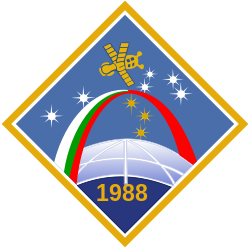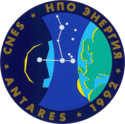Anatoli Jakowlewitsch Solowjow
| Anatoli Solowjow | |
|---|---|
 | |
| Land | UdSSR/Russland |
| ausgewählt | 1. März 1978 |
| Einsätze | 5 Raumflüge |
| Start des ersten Raumflugs | 7. Juni 1988 |
| Landung des letzten Raumflugs | 19. Februar 1998 |
| Zeit im Weltraum | 651d 0h 3min 28s |
| EVA-Einsätze | 16 |
| EVA-Gesamtdauer | 78h 48min |
| ausgeschieden | Februar 1999 |
| Raumflüge | |
| |
Anatoli Jakowlewitsch Solowjow (russisch Анатолий Яковлевич Соловьёв; * 16. Januar 1948 in Riga, Lettische SSR) ist ein ehemaliger sowjetischer und russischer Kosmonaut. Er ist verheiratet und hat zwei Söhne.
Ausbildung
Solowjow schloss die Luftfahrthochschule „Leninscher Komsomol“ in Tschernigow 1972 ab. Daraufhin wurde er Pilot im östlichsten Militärbezirk der Sowjetunion.
Kosmonaut
1976 entschloss er sich, eine Kosmonautenausbildung zu beginnen. Nachdem er in den engeren Kreis der zukünftigen Kosmonauten aufgenommen worden war, begann 1979 sein spezielles Kosmonautentraining. Er wurde für Missionen mit dem Raumschiff Sojus-T sowie für die Raumstationen Saljut-7 und Mir ausgebildet. Ab 1981 nahm er daraufhin an fünf Missionen teil, die ihn auch auf die Raumstationen führten.
Solowjow verbrachte während seiner fünf Weltraumexpeditionen zwischen 1988 und 1998 insgesamt 82 Stunden 22 Minuten im freien Raum – mehr als jeder andere Astronaut bisher.[1] Er führte während seiner fünf Weltraumflüge 16 Weltraumspaziergänge durch. Solowjows Weltraumflüge führten alle zur Raumstation Mir. Im Laufe seiner fünf Missionen verbrachte Solowjow insgesamt 651 Tage im Weltraum. Seine letzte Mission endete mit der Landung von Sojus TM-26 am 19. Februar 1998.[2] Er war außerdem Teil der Crew der Atlantis, welche das erste Docking eines Space-Shuttles durchführte. Dies war außerdem das erste Mal, dass eine Shuttle-Crew im Orbit wechselt.[3]
Auszeichnungen
- Leninorden
- Medaille „Goldener Stern“
- Orden der Oktoberrevolution,
- Orden der Völkerfreundschaft sowie sechs andere militärische Auszeichnungen
Siehe auch
Weblinks
- Kurzbiografie von Anatoli Jakowlewitsch Solowjow bei spacefacts.de
- Biografie von Anatoli Jakowlewitsch Solowjow beim Juri-Gagarin-Kosmonautentrainingszentrum (russisch)
- Biografie von Anatoli Jakowlewitsch Solowjow in der Encyclopedia Astronautica (englisch)
Einzelnachweise
- ↑ Most accumulated time on spacewalks. Abgerufen am 13. Juni 2021 (deutsch).
- ↑ Most spacewalks by one person. Abgerufen am 13. Juni 2021 (deutsch).
- ↑ First shuttle docking. Abgerufen am 13. Juni 2021 (deutsch).
| Personendaten | |
|---|---|
| NAME | Solowjow, Anatoli Jakowlewitsch |
| ALTERNATIVNAMEN | Анатолий Яковлевич Соловьёв (russisch) |
| KURZBESCHREIBUNG | sowjetischer und russischer Kosmonaut |
| GEBURTSDATUM | 16. Januar 1948 |
| GEBURTSORT | Riga, Lettische SSR, Sowjetunion |
Auf dieser Seite verwendete Medien
The official crew patch for the Russian Soyuz TM-26 mission, which delivered the EO-24 crew to the space station Mir.
Patch for the Mir EO-19 expedition to the Mir space station in 1995.
The patch was redrawn by Jorge Cartes (JCR).
STS-71 Anatoly Y. Solovyev arrives at KSC in T-38
The official crew patch for the Soviet Soyuz TM-5 mission, which delivered the EP-2 crew to the space station Mir.
STS-71 Mission Insignia
The STS-71 crew patch design depicts the orbiter Atlantis in the process of the first international docking mission of the Space Shuttle Atlantis with the Russian Space Station Mir. The names of the 10 astronauts and cosmonauts who flew aboard the orbiter are shown along the outer border of the patch. The rising sun symbolizes the dawn of a new era of cooperation between the two countries. The vehicles Atlantis and Mir are shown in separate circles converging at the center of the emblem symbolizing the merger of the space programs of the two space faring nations. The flags of the United States and Russia emphasize the equal partnership of the mission. The joint program symbol at the lower center of the patch acknowledges the extensive contributions made by the Mission Control Centers (MCC) of both countries. The crew insignia was designed by aviation and space artist, Bob McCall, who also designed the crew patch for the Apollo Soyuz Test Project (ASTP) in 1975, the first international space docking mission.
The official crew patch for the Russian Soyuz TM-15 mission, which delivered the EO-12 and Antares crews to the space station Mir.






